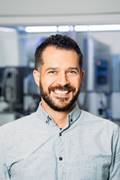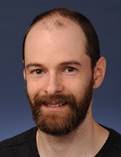|
|
Australasian Colloid and Interface Society Web: http://acis.wildapricot.org/; E-mail: acis.enquiries@gmail.com |
|
ACIS Newsletter – Issue 24, March 2021
Welcome
Dear members,
Welcome to our 24th issue of ACIS News! We produce a quarterly newsletter - sent around in February, May, August, and November (approximately) - to keep ACIS members informed of our initiatives and for members to directly communicate with our Society. We publish job announcements, meetings of interests to our society, career development opportunities and any exciting research that you would like to share with us. To keep you up to date with the on-goings in our colloids society, please send your suggestions and items for the next newsletter to christine.browne@monash.edu or Stuart Brown at s3399895@student.rmit.edu.au.
President’s Corner
Welcome to the first ‘President’s Corner’ of 2021. I would like to introduce the new Board of Directors. Tam Greaves is our new Vice President, Deborah Wakeham is continuing as Honorary Treasurer, Arlene McDowell is continuing as Membership officer and Christine Browne is our ongoing Communications officer. Frank Sainsbury is our new Equity Officer and Joe Berry will chair the Awards subcommittee. Michael Higgins will complement us as activities occur throughout the year. Last, but not least, Grant Webber will continue to keep an eye on us all as the society’s Honorary Secretary. Welcome everyone and many thanks to our outgoing Board members for helping ACIS to be so successful during their terms and particularly during COVID-19: Ben Boyd, Gunther Andersson, Charlotte Conn and Greg Warr.
Another huge vote of thanks goes to Rico Tabor and his ACIS2021 team for showing us how a blended conference of geographical hubs can succeed. The value proposition was excellent for those attending a hub in person, and everyone found they could still deliver on their home commitments at the same time. However, I do recognise that those at smaller hubs or unable to travel benefitted far less. Either way I’m sure we have learned a lot as a community. Please pass any feedback to Rico, or to the Board.
Congratulations can be announced now that your new Board has ratified the following award recipients. Dr Joe Berry of Melbourne University is the 2021 ACIS ECR lecturer and could soon be coming your way to deliver his seminar on Capsules, drops and cells: Measurement in complex soft matter systems. Dr Durga Dharmadana of RMIT has been selected for the best PhD Thesis award for her 2020 thesis entitled “Interactions of neuropeptide functional amyloids with biomolecules: insights into biological relevance and potential as bionanomaterials”. Highly meritorious Durga and Joe!
Your Board is keen to capitalise on what we learned in terms of online events in 2020. If you have great ideas or wish to organise/host an event throughout this year, please forward your ideas to acis.enquiries@gmail.com
In closing I would just like to wish everyone well who has been working hard to submit competitive grant proposals. I hope you get funded, and at 100% of what you requested! For those assessing proposals, remember to be constructive in your feedback, and see the proposals of colleagues in the field as healthy competition that should be supported unless the science case presented is flawed. Let’s see our new FOR code 340603 (replacing 030603) shine in terms of fellowships and grants awarded in 2021. Good luck everyone.
Erica Wanless (President)
News
Opinions Required: Possible Submission to the Federal Government
ACIS is considering making a submission to the Federal Government in relation to their consultation paper, University Research Commercialisation.
See the minister's media announcement here and which has links to the consultation paper therein, or click here for a direct link to download the paper.
As timing is short, we would like to invite members to send us their opinion on the government paper and proposal, by Thurs 25 March via email to acis.enquiries@gmail.com. We would be happy to receive any opinion, detailed or short. Any response is welcome, but you may find the questions below and the discussion questions proposed by the government on page 10 of the consultation paper useful.
Questions:
- What are current road-blocks to translation? What holds back commercialisation?
- Is Australia underselling its achievements and there's more IP transfer than is immediately visible?
- Is the proposal likely to achieve its goal of putting "research at the heart of our economic recovery"?
- What is the right balance in funding between 'mission-driven research' and 'fundamental research'?
- What is the university's key contribution to industry (and what does industry actually think it should be): is it the smart graduates? is it the research outcomes?
- What is the right balance between "increasing collaboration between business and universities" and the independence and freedom of academic researchers?
- What is holding back industry/university relationships and collaborations (both broadly speaking and for physics in particular)? What incentives are needed for the university (and their academics), and which ones would help industry?
- Is it in the best interest of our country to tie university research closely to industry engagement? (perhaps to be discussed in the context that the Job Ready Graduate package already severed the close tie between teaching and research)
- What are examples of great achievements of the physics community (in the commercialisation space / contribution to industry) that we may wish to highlight?
- What attracts the brightest young minds into science and what helps them develop most: Fundamental science or opportunities for industry engagement (or both)?
You might also be interested in the opinion already expressed by STA, the Deans of Science, UA and G8 all of which seem to be supportive.
We look forward to hearing your thoughts. Once we have received your responses, we are hoping to put together a draft submission and discuss within the Board given the short timeframe for submission by 9 April.
Thanks to member Gerd Shroeder-Turk for inspiring this action via the Australian Institute of Physics.
Our New ACIS Board Members:
Introducing…
I am a Group Leader at the Griffith Institute for Drug Delivery and Senior Lecturer in the School of Environment and Science at Griffith University. I completed a PhD in Plant and Microbial Science at the John Innes Centre in the UK (2009) where I first started working with nature’s nanotechnology; viruses. After a postdoc at Laval University in Quebec City where I worked with company making virus-like particle vaccines, I moved to a chemical engineering lab at the University of Queensland. During an ARC DECRA at UQ I became fascinated with the biophysics of virus capsids and started a research stream on using peptide surfactants to stabilised liquid-liquid interfaces. I joined Griffith University in 2019 where I hold a CSIRO Synthetic Biology Future Science Platform Fellowship. I chair the ACIS Equity and Diversity Committee, which is committed to recognising, supporting, and promoting diversity amongst ACIS members at large, and at the ACIS and student conferences.
I completed my PhD at Monash University in 2010 in the Department of Mechanical Engineering. I then worked as a research fellow modelling multiphase flows in the Department of Chemical Engineering at the University of Melbourne, before a three-year stint at CSIRO developing models of flows within small- and large-scale stem-cell bioreactors. In 2015 I returned to the University of Melbourne where I am now working as a lecturer in Chemical Engineering. My research focusses on the development and application of numerical models to solve complex, multi-disciplinary engineering problems, spanning areas such as microfluidics, soft matter, colloid science, and biological flows. A particular focus of my research is the translation of complex numerical models to easily applicable tools to enable impact and discovery in a range of relevant fields
I am an Associate Professor within Physics at RMIT University and have been at RMIT since 2014. I completed my Ph.D. in Experimental Physics in 2004 at Monash University, Australia. In 2005 I joined CSIRO as a Postdoctoral Fellow and worked there for nearly 10 years. I am a frequent user of the Australian Synchrotron, particularly the SAXS/WAXS beamline, and a former chair of the SAXS/WAXS Program Advisory Committee. I am currently a member of the advisory committee for the BioSAXS beamline which is being built. My research is based around understanding the fundamental physicochemical and thermal properties of ionic liquids, their mixtures, liquid nanostructure, and solvation properties. I am currently developing ionic liquid solvents for use with biological molecules in a broad range of applications, including protein solubility, stability and crystallization. A key focus of my research is the development of high throughput methodologies for experimental design, sample synthesis, characterisation and data analysis.
Michael is a Professor at University of Wollongong within the Australian Institute for Innovative Materials and Intelligent Polymer Research Group. His research focuses on the development of material surfaces for biomedical and industrial applications, with an underlying theme of understanding how biological systems interact with materials. This addresses the need to better understand the effect of nanoscale structures, mechanical properties and chemistries of materials on the interactions with proteins and cell surface molecules.
Exciting New Project – New Eco-Friendly Nanoparticles for use in Organic Photovoltaic Fabrication
Riku Chowdhury, a PhD student from the Centre for Organic Electronics at The University of Newcastle is excited to share is recent work completed in conjunction with this co-workers Natalie Holmes, Warwick Belcher, Paul Dastoor, and Xiaojing Zhou. They have discovered an aqueous-based system for organic photovoltaic fabrication. They created a P3HT:PC61BM nanoparticle-based ink which was synthesized with the water soluble 2-(3-thienyl) ethyloxybutylsulfonate (TEBS) surfactant. The internal morphology of the nanoparticles has been characterized and are shown below. Interestingly, the shape of the nanoparticles studied in this new project are semi-spherical rather than angular when using sodium dodecyl sulphate (SDS) surfactant. This shape changes along with results from UV-vis absorbance and XRD measurements indicate that the new nanoparticles have a lower crystallinity. These new nanoparticles also offer the benefit of an intermixed donor-acceptor nanodomains compared with the donor-rich shell and acceptor-rich core of the more conventional systems. This discovery offers a new strategy of greatly improving the performance of organic photovoltaic fabrication with the added benefits of being eco-friendly.
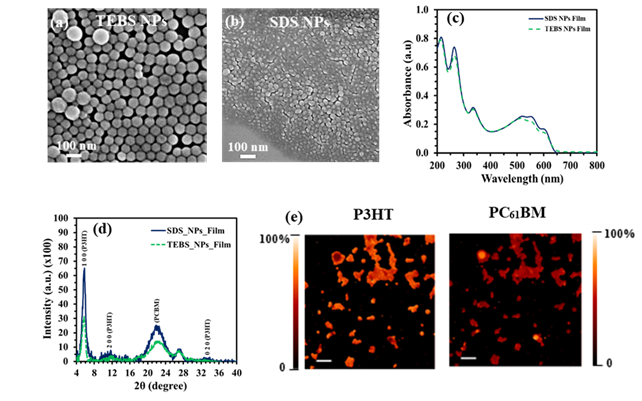 |
Scanning electron microscopy (SEM) images of (a) TEBS and (b) SDS surfactant processed blend NPs. (c) UV-Vis absorbance spectra and (d) X-ray diffraction (XRD) pattern of blended TEBS-NPs (green dashed line) and SDS-NPs (blue solid line) spun casted on glass substrates as thin films. (e) STXM fractional composition maps showing the concentration of (i) P3HT and (ii) PC61BM in the blended P3HT: PC61BM NPs where scale bar is 500 nm.
If you wish to find out more information about this exciting project you can contact Riku Chowdhury, Riku.Chowdhury@uon.edu.au.
Awards
Sydney Poster Award Winners
Congratulations to the winner of the ACIS2021 Sydney hub student poster prize, Sally Gao from the University of Sydney (in photo with Chiara Neto). The prize for the runner-up was awarded to Shurui Miao from the University of Sydney.
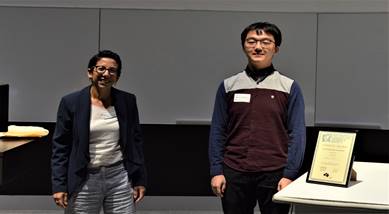 |
|||||||
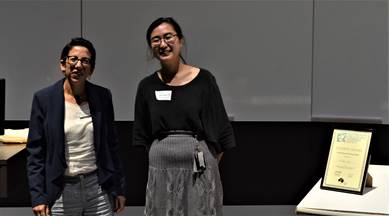 |
|||||||
 |
 |
||||||
Call for Nominations: 2021 JCIS Darsh Wasan Award
The Journal of Colloid and Interface Science is currently seeking nominations for the 2021 JCIS – Darsh Wasan Award. The annual award, given for the first time in 2007, for outstanding contributions to the field of surface and colloid chemistry.
The Awardee is expected to deliver a Plenary Lecture at the 11th International Colloids Conference in Palma, Spain, December 2021 as well as a feature article manuscript on the award lecture, to be published in the Journal of Colloid and Interface Science, subject to peer review.
The Awardee will receive a EUR 2,500 honorarium, free registration at the 11th International Colloids Conference, as well as travel reimbursement.
For more information click here. Nominations should be sent as a single pdf file to Rob van Daalen, (g.daalen@elsevier.com) by 1 July 2021.
Opportunities
New opportunities are posted between issues of the newsletter on the ACIS website.
Bordeaux Summer School – Soft Matter for Functional Materials #3
The organizing team of the SoFun # 3 international summer school is happy to announce that, after cancelling the 2020 edition due to Covid19, we are proposing an online version, which will be held from 14 to 18 June 2021. The theme remains the same: Surface Patterning and Colloidal Assembly. Most of the speakers are the same as those planned last year.
Applications are already open and as the number of participants is limited, the first to submit their application will be the first to register. For more information click here.
PhD Opportunities at RMIT
Self-Assembled Lipid Nanoparticles for Targeted Cancer Therapeutics
The Molecular Assembly Group within the School of Science, RMIT University (city campus) is looking for a passionate researcher to join our group to undertake an exciting multidisciplinary PhD project – “Self-assembled lipid nanoparticles for targeted cancer therapeutics”. Detailed project information can be found at https://www.findaphd.com/phds/project/self-assembled-lipid-nanoparticles-for-targeted-cancer-therapeutics/?p128888.
For further information and enquiry, contact Dr Jiali (Maggie) Zhai (maggie.zhai@rmit.edu.au)
Light Scattering Techniques for Characterising Blood Platelets in Solution
Human platelets are one of the key cell types found in whole blood. They have a primary role of halting blood flow, where they are essential to maintain the integrity of the vascular system. Blood services globally face logistic challenges due to the short shelf life: the daily demand is unpredictable, so balancing an adequate inventory without incurring excessive wastage is problematic. In 2018, ~ 150,000 units of platelets were supplied to hospitals in Australia, and approximately 9% (13,000) were not transfused due to expiry, with an estimated cost of $7.5 million. Methods for safe long-term storage could prevent large amounts of wastage and save millions of dollars per annum. When stored in the cold or cryopreserved, platelets change morphology from their resting discoid shape to a more spherical form, accompanied an increase in microparticle formation along with a range of biochemical changes. This project will develop new methods for the characterization of the platelet’s morphology and their associated microparticles using light scattering techniques, and use this knowledge to develop improved long-term storage strategies for platelets. The experimental program will involve several related techniques: 1) Combined Static and Dynamic Light Scattering (MDLS). DLS is a standard technique. However, very few labs have the expertise to conduct combined multi-angle Static and Dynamic Light Scattering. CI Bryant is a world leader in the application of such techniques, from early work on MDLS for the extraction of particle size distributions, to the accurate characterization of nanoparticle shape and conformation. 2) Small angle X-ray scattering (SAXS). Small angle X-ray scattering is a powerful technique for determining the shape of particles in solution. CI Bryant has been investigating biological problems using SAXS and related techniques such as small angle neutron scattering (SANS), for his whole career, including understanding the interactions between proteins and membranes and for characterizing complex particles in solution. The PhD student will work in collaboration with a research fellow who will handle the biology and platelet preparation. The PhD student should have a good Honours degree or equivalent in Physics, Physical Chemistry, Applied Maths or Engineering.
Other information:
•
Stipend: $31,000 per annum (pro rata), for 3 years with possible extension to
3.5 years.
• Opening date: 24/02/2021
• Closing date: 30/04/2021
• Eligibility: Good Honours or Masters degree in Physics, Biophysics, Physical
Chemistry or related fields.
• Suitably qualified International students who are currently residing in
Australia may be eligible for a fee scholarship.
How to apply:
Please
submit the following documents to the email below:
• A cover letter (research statement)
• A copy of electronic academic transcripts
• A CV that includes any publications/awards and the contact details of 2
referees.
Contact Details: To discuss this project further please contact: Prof Gary Bryant (gary.bryant@rmit.edu.au)
Collaboration Opportunity With ANSTO
Core - Shell Nanoparticles for Microplastic Radiotracers
Dr Tom Cresswell from ANSTO is searching for a collaborator experienced in the manufacture of metal core/polymer shell nanoparticles for a project producing microplastic radiotracers. The goal is to produce a microplastic radioisotope tracer that can trace microplastics through live aquatic organisms. The current technique for tracing microplastics in live marine biota is via the use of fluorescent microspheres. However, this requires the organism is translucent and will not work in many crustaceans, bivalves and fish.
For more information about this project, please contact: Dr Tom Cresswell Tom.Cresswell@ansto.gov.au. +61 (0) 2 9717 9412
Activities
Join our Awards, Communications, Conferences and Events Committees
ACIS needs its members to be actively engaged. Please let us know if you would like to be involved in the committees that will run the activities of the Society: Awards; Communications; Conferences and Events. Or if you would like to propose other activities we should be running. We especially invite students and early-career researchers to become involved. Please email your interest to acis.enquiries@gmail.com.
Visiting Scientist Register
Are you planning to host a visit by an outstanding scientist in the colloid and interface field? Why not let ACIS members know about the visit? We aim to keep track of visiting scientists, to facilitate their introduction to the Australasian scientific community. Please email details of the visit to acis.enquiries@gmail.com.
ACIS Membership
Please encourage your colleagues, students and industrial partners working in the field of colloids and interface to join us. General membership is $100 per annum. The membership year is from 1st March each year. Memberships paid after this date are valid until 28th February of the following year. More information is available on our website http://acis.wildapricot.org/.
 Use Our LinkedIn
Group to Tell People Your News
Use Our LinkedIn
Group to Tell People Your News
ACIS is now present on LinkedIn. Please join our LinkedIn group and post discussion items on job ads, conference calls, and interesting facts about the wonderful world of colloid and surface science.
 Or Tag your Friends and Colleagues
Or Tag your Friends and Colleagues
Share your next big breakthrough, job opportunity or beautiful science with the ACIS community by using @AusColloids.
![]()
![]() The Newsletter team is:
The Newsletter team is:
Christine Browne – christine.browne@monash.edu
Stuart Brown – s3399895@student.rmit.edu.au


